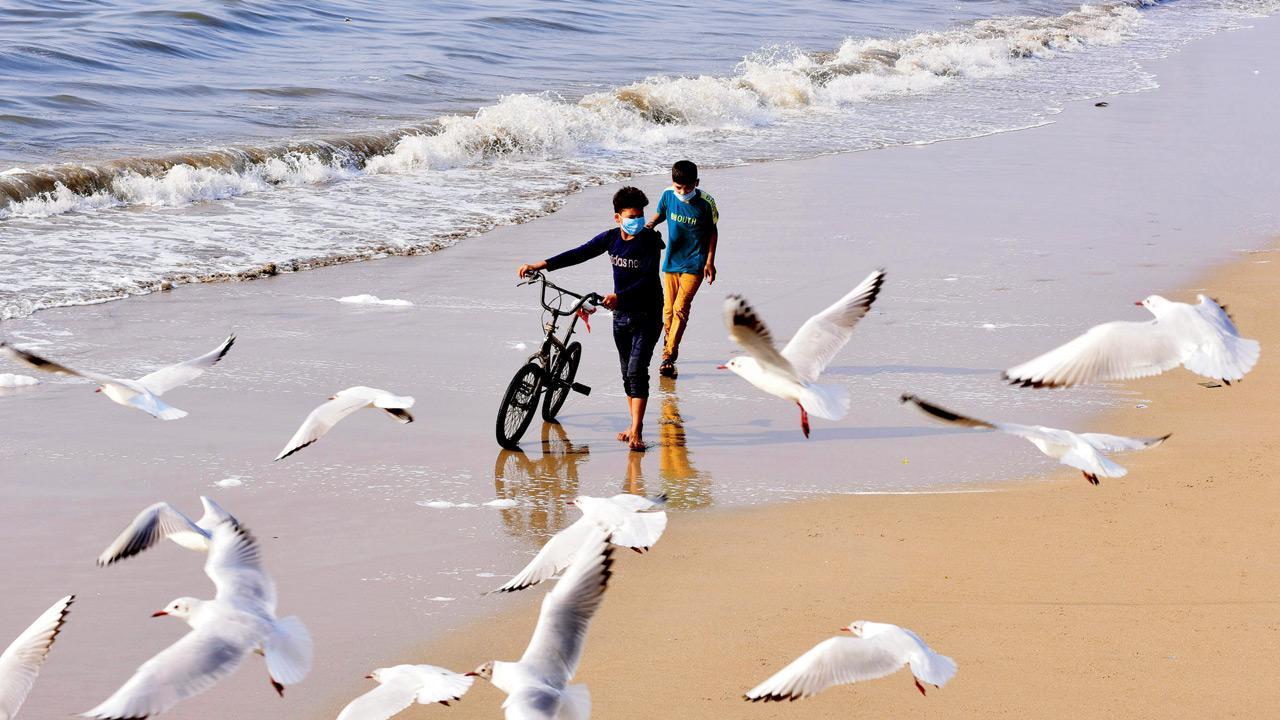The city - sliced, diced and served with a dash of sauce

Pic/Shadab Khan
Gull-y Boys
ADVERTISEMENT
A flock of seagulls and two kids make the most of a clear day at Mahim beach.
The mascot’s magic
The Air India Maharaja — a figure clad in red, sporting a striped turban and a giant moustache — remains the much-adored mascot for Indians and tourists to this day. Conceptualised by the then commercial director of the airline, Bobby Kooka, this mascot evolved over the years, attracting citizens and foreigners alike to fly the ‘palace in the sky’ as they called the airline. Tomorrow, a session hosted by the Chhatrapati Shivaji Maharaj Vastu Sangrahalaya (CSMVS) in collaboration with the Museum Society of Mumbai (MSM) will dive into the history of this iconic figure, while also tracing the journey of Air India through the decades.
The Air India mascot. Pic Courtesy/ Wikimedia Commons
The event, titled The Magic of the Maharaja, will be helmed by Air India memorabilia collector Piyush Khaitan. “Air India used the Maharaja a lot; while promoting flights, they would have their jumbo jets decorated with him dancing with Gopis, Krishna and visuals of Vrindavan. These are visuals you couldn’t find anywhere else. Being aware of this background, I approached Khaitan to lead the talk,” said Pheroza Godrej, chairperson of MSM. If you’re keen to know more, log on to @museumsocietyof-mumbai on Instagram.
A roaring success
Ashutosh Chaturvedi and Pankaj Mavchi
In 2017, Mumbai-based directors Ashutosh Chaturvedi and Pankaj Mavchi came across an article about the UP district Pilibhit, which houses a tiger reserve. What intrigued them was how people in the region were in such dire need of financial support that they would get their parents or the elderly killed by tigers to avail government compensation. This prompted them to visit Pilibhit, which they found is the flute bowl of India, where the instrument is hand-crafted by artisans. “But we realised that the industry was dying. So, we decided to merge these narratives together,” said Chaturvedi about the duo’s film Pilibhit, which is making waves at film festivals. Most recently, it was picked as the semi-finalist at the Flickers’ Rhode Island International Film Festival. The film revolves around Siraj, a poor flute-maker
residing with his family at the edge of the forest, he shared. “Pilibhit refers to the yellow wall that nomads living there would build to protect themselves from tigers. We’ve extended the metaphor of the wall to Siraj’s life and the moral line of transgression,” he added.
Jumping to their rescue
A view of the flood-hit areas in Raigad. Pic Courtesy/PTI
The torrential rainfall that the state has been witnessing has led to severe destruction of life and property. Mumbai-based travel and adventure design company, Jumpstart Outdoors, has initiated a fundraiser to extend support to those affected. They’re also collecting ration and other essentials. “Last year, too, we had undertaken a similar initiative. We know and work with a lot of people in the Raigad-Ratnagiri belt who’ve been affected by the floods this year. We’re currently looking at sending across the donations to Raigad and Badlapur areas,” shared founder Dhiren Talpade. To pitch in, call 9152735256.
Empowering young guides
In a boost for tourism and employment opportunities, Maharashtra’s Directorate of Tourism, along with Indian Institute of Tourism and Travel Management, is carrying out a five-day guide training programme from today for 31 members of the tribal community, at Karnala and Phansad sanctuaries. The sessions will cover topics such as introduction to touri-sm, responsibilities of a guide, and biodiversity. About time, we say.
Ode to Babasaheb
A sketch of Purandare by Chemburkar
On July 29, Balwant Moreshwar Purandare, fondly known as Babasaheb Purandare, turned 100. Celebrating the momentous occasion was architect Rahul Chemburkar, who shared a sketch of the visionary writer, theatre personality and leader online. “His life was dedicated to exploring the legacy of Maharashtra and researching the life and times of Shivaji Maharaj. He’s been pivotal in bringing Shivaji out from historical archives and into the contemporary zeitgeist,” he told us, adding how it’s incredible for him to be alive in the same era as Purandare, who had not only witnessed crucial turning points in our country’s history [from the Independence movement and the Emergency, to the formation of Maharashtra], but had also shaped it with his social and revolutionary movements. “I met him in 1998 as a budding architect. He told me that he had purchased land from the government to create a theme park dedicated to Shivaji’s life. Since then, I have been associated with him on various projects. Our shared dream is now inching closer to reality and we are eager to see it come to life,” he shared.
 Subscribe today by clicking the link and stay updated with the latest news!" Click here!
Subscribe today by clicking the link and stay updated with the latest news!" Click here!






